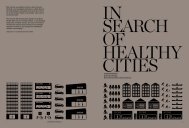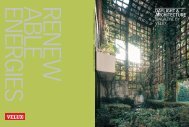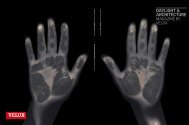Download as PDF - Daylight & Architecture - Magazine by | VELUX
Download as PDF - Daylight & Architecture - Magazine by | VELUX
Download as PDF - Daylight & Architecture - Magazine by | VELUX
You also want an ePaper? Increase the reach of your titles
YUMPU automatically turns print PDFs into web optimized ePapers that Google loves.
Body Clocks,Light, Sleepand HealthThe eye establishes a connectionto the outer world not onlyfor our sense of sight but also forour sense of time and for manytemporal processes in our body.Over the l<strong>as</strong>t one and a half centuries, artificial light and the restructuringof working times have seemingly ‘liberated’ us from the diurnal cyclesof light and dark that nature imparts on us. Yet recent research h<strong>as</strong>shown that this separation from nature comes at a considerable cost,causing health and social problems. A reconnection to the rhythms ofnature is therefore needed – and this will also have a profound influenceon architecture.By Russell G. FosterIllustrations <strong>by</strong> Ulrika Nilsson CarlssonOur lives are ruled <strong>by</strong> time and we usetime to tell us what to do. But the digitalalarm clock that wakes us in the morningor the wrist-watch that tells us we are latefor supper are unnatural clocks. Our biologyanswers to a profoundly more ancientbeat that probably started to tick early inthe evolution of all life. Embedded withinour genes, and almost all life on earth, arethe instructions for a biological clock thatmarks the p<strong>as</strong>sage of approximately 24hours. Biological clocks or ‘circadianclocks’ (circa about, diem a day) helptime our sleep patterns, alertness, mood,physical strength, blood pressure andmuch more. Under normal conditions weexperience a 24-hour pattern of light anddark, and our circadian clock uses this signalto align biological time to the day andnight. The clock is then used to anticipatethe differing demands of the 24-hour dayand fine-tune physiology and behaviourin advance of the changing conditions.Body temperature drops, blood pressuredecre<strong>as</strong>es, cognitive performance dropsand tiredness incre<strong>as</strong>es in anticipationof going to bed. Whilst before dawn, metabolismis geared-up in anticipation ofincre<strong>as</strong>ed activity when we wake.Few of us appreciate this internal world,seduced <strong>by</strong> an apparent freedom to sleep,work, eat, drink, or travel when we want.But this freedom is an illusion; in realitywe are not free to act independently of thebiological order that the circadian clockimparts. We are unable to perform withthe same efficiency throughout the 24hday. Life h<strong>as</strong> evolved on a planet that experiencesprofound changes in light overthe 24h day and our biology anticipatesthese changes and needs to be exposedto the natural pattern of light and darkto function properly. Yet we detach ourselvesfrom the environment <strong>by</strong> forcingour nights into days using electric light,and isolate ourselves in buildings thatshield us from natural light. This shortreview considers some of the importantconsequences of our incre<strong>as</strong>ing detachmentfrom the sun.The day withinAt the b<strong>as</strong>e of the brain, in a structureknown <strong>as</strong> the anterior hypothalamus, isa cluster of about 50,000 neurones known<strong>as</strong> the suprachi<strong>as</strong>matic nuclei or SCN. Ifthis region is destroyed <strong>as</strong> a result of <strong>as</strong>troke or tumour, then 24h rhythmicityis lost and physiology becomes randomlydistributed across the day. The findingthat individual SCN neurones, isolatedfrom all other cells, show near 24-hourrhythms in electrical activity demonstratedthat the b<strong>as</strong>ic mechanisms thatgenerate this internal day must be partof a sub-cellular molecular mechanism.To date, approximately 14-20 genes andtheir protein products have been linkedto the generation of circadian rhythms.At the heart of the molecular clock is anegative feedback loop that consists of thefollowing sequence of events: the clockgenes are transcribed and the messengerRNAs (mRNAs) move to the cytopl<strong>as</strong>m ofthe cell and are translated into proteins;The proteins interact to form complexesand then move from the cytopl<strong>as</strong>m intothe nucleus and inhibit the transcriptionof their own genes; the inhibitory clockprotein complexes are then degradedand the core clock genes are once morefree to make their mRNA and hence freshprotein. This negative feedback loop generatesa near 24-hour rhythm of proteinproduction and degradation that encodesthe biological day.The original <strong>as</strong>sumption w<strong>as</strong> that SCNneurones collectively drive or impose a24h rhythm on physiology and behaviour.However, the discovery that isolated cellsfrom almost any organ of the body produceclock genes/proteins in a circadianpattern led to a major shift in our understanding.We now appreciate that the SCNacts <strong>as</strong> a m<strong>as</strong>ter pacemaker, coordinatingthe activity of all cellular clocks in a mannerthat h<strong>as</strong> been likened to the conductorof an orchestra, regulating the timing ofthe multiple and varied components ofthe ensemble. In the absence of the SCN,the individual cellular clocks of the organsystems drift apart and coordinated circadianrhythms collapse – a state known <strong>as</strong>internal desynchronisation. Internal desynchronisationis the main re<strong>as</strong>on whywe feel so awful <strong>as</strong> a result of jet lag. All thedifferent organ systems, the brain, liver,gut, muscles etc., are working at a slightlydifferent time. Only when internal timeh<strong>as</strong> been re-aligned can we function normallyonce more.7










